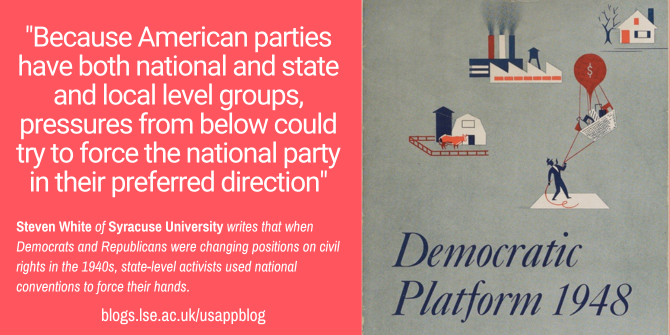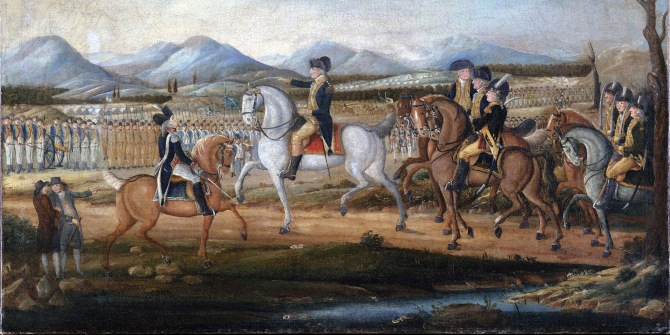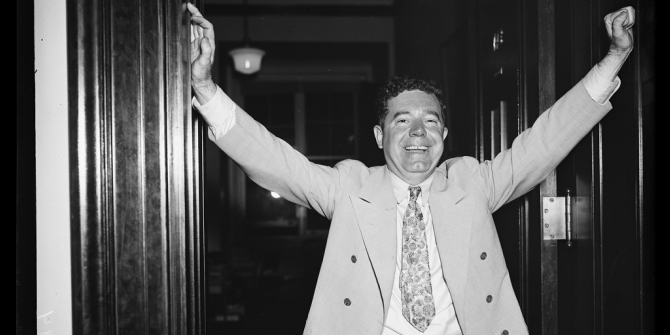 The 1960s are generally considered to be the time of the greatest activism and change in civil rights in America, but in new research, Steven White sheds light on the 1930s and 1940s as a critical period in US politics that set the stage for later reform. He finds that state-level political party organizations – often Black-led – put pressure on the national Democratic Party to make its platform more liberal on civil rights during presidential nominating conventions in the 1940s.
The 1960s are generally considered to be the time of the greatest activism and change in civil rights in America, but in new research, Steven White sheds light on the 1930s and 1940s as a critical period in US politics that set the stage for later reform. He finds that state-level political party organizations – often Black-led – put pressure on the national Democratic Party to make its platform more liberal on civil rights during presidential nominating conventions in the 1940s.
During the twentieth century, America’s two political parties switched positions on civil rights. Democrats, formerly the party of the white South, became the party of northern white liberals and Black voters. Republicans, once the party of emancipation and Reconstruction, became the party of most southern whites. While older research dated this change to the upheavals of the 1960s civil rights era, a new generation of scholarship has emphasized the 1930s and 1940s as the critical period setting this change into motion.
Democratic Party elites faced a choice during this time: they could focus on maintaining their traditional white southern electorate or they could reach out to Black voters and others in northern cities supportive of the party’s New Deal economic programs. In the short term, President Franklin Roosevelt and other party leaders sought to do both. But over the longer term, this wouldn’t last. And because American parties have both national and state and local level groups, pressures from below could try to force the national party in their preferred direction.
Pressures on the national party from state delegations
National presidential nominating conventions were a key site where these disputes played out. In new research, I examine two distinct sets of issues that the national party was forced to confront in this era. The first had to do with state delegation credentials. Starting in 1944 and then unfolding over the next several Democratic conventions, activists—including groups of Black southerners seeking to participate in electoral politics in the region—challenged the seating of all-white southern delegations. In 1944, South Carolina’s Progressive Democratic Party— a Black-led “third party” aiming to challenge the state Democratic Party’s racial restrictions—came before a DNC subcommittee to advocate for representation on South Carolina’s delegate slate. They were rejected on technical grounds. In 1948, they again brought their claim and were again denied.
This time, however, there was a challenge to the Mississippi delegation as well. Although the Mississippi challenge was defeated by the committee behind closed doors, a minority report was publicly presented on the convention floor by George Vaughan, a Black lawyer from Missouri. Supportive state delegations demanded to go on the record in support of his report. In the end, 41 percent of delegates to the convention publicly affirmed their support for unseating the all-white Mississippi delegation. Although not successful in their immediate goal, I view this near miss as a helpful illustration of which state-level party actors were willing to take a forthright stand in favor of moving the party towards civil rights liberalism (and which were not).
The Democratic Party’s internal fight over civil rights
The second issue was platform language about civil rights. In 1948, the convention debated whether to change the platform language on this issue. The initial draft was generally pro-civil rights, but vague in its specifics. Some southern whites advocated for removing even this and instead affirming the party’s commitment to “states’ rights.” These proposals were quickly rejected. Liberals alternately advocated for strengthening the platform language. After a stirring speech from Minneapolis mayor Hubert Humphrey, this was ultimately passed via a roll call, culminating in a walkout of several southern white delegates.

Credit: Democratic Platform, 1948. Pamphlet. Joseph Rauh Papers, Manuscript Division, Library of Congress (071.00.00)
When forced to take a vote on these issues, non-southern Democratic actors at the national party convention placed themselves into three coalitions: liberals that supported both types of challenges, moderates that supported the platform language change but not the challenge to other delegates’ credentials, and conservatives that sided with the white South by supporting neither.
Which states were more likely to be liberal on civil rights?
I combined the votes on the delegation credentials and platform language change with state-level demographic information to see what “types” of states were most likely to produce delegations joining the liberal side. Statistically speaking, these delegations tended to be from bigger states and those with quickly growing Black populations. New York exemplifies this trend and indeed such large, diverse states did play central roles in the Democratic Party’s national movement towards racial liberalism more broadly. However, there are some important outliers, with several smaller and whiter states in the upper Midwest (like Minnesota and Iowa) also supporting both the delegation and platform language votes at the 1948 convention. Minnesota, for example, only had about 14,000 Black residents (out of a population of nearly three million), yet its state delegation (and politicians like Hubert Humphrey) was at the forefront of pushing the party in a more liberal direction on civil rights.
Beyond the specifics of the civil rights realignment, this kind of analysis also has implications for other questions about parties and political change. For example, it wasn’t clear in the mid-1970s which party would be a better “fit” for conservative Evangelical Christians and the issue positions they were advocating (like opposition to abortion). Over time, however, it became clear that these issues would become tied to the Republican Party. This development proceeded unevenly across time and space, however, with some state Republican parties resisting this change and others being early adopters. State delegation behavior at national conventions could offer useful insights into the geography of this process (and others) that made America’s political parties into what they are today.
- This article is based on the paper, ‘State Parties, the Democratic National Convention, and Civil Rights Liberalism’, in The Journal of Race, Ethnicity, and Politics.
- Please read our comments policy before commenting.
- Note: This article gives the views of the author, and not the position of USAPP – American Politics and Policy, nor the London School of Economics.
- Shortened URL for this post: https://bit.ly/3LgWdLq






